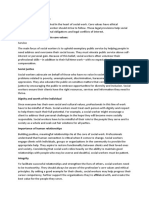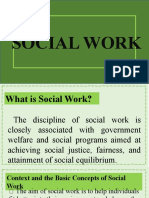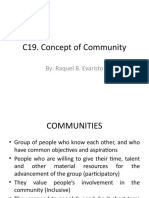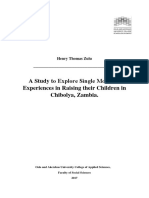0 ratings0% found this document useful (0 votes)
793 views21 pagesSample Chapter - Foundations of SW Practice
Foundations of Social Work
Uploaded by
gracesandicoCopyright
© © All Rights Reserved
We take content rights seriously. If you suspect this is your content, claim it here.
Available Formats
Download as PDF or read online on Scribd
0 ratings0% found this document useful (0 votes)
793 views21 pagesSample Chapter - Foundations of SW Practice
Foundations of Social Work
Uploaded by
gracesandicoCopyright
© © All Rights Reserved
We take content rights seriously. If you suspect this is your content, claim it here.
Available Formats
Download as PDF or read online on Scribd
You are on page 1/ 21
1
Foundations of Social Work
Practice
‘Mark A. Mattaini and Casey Holtschneider
Although social workers perform many tasks in an expanding number of settings,
the essential work of social work is to realize a progressive vision ofa just and
caring society. This mission requires integrated practice that challenges oppres-
sion and structural violence, offers care and accompaniment for casualties of that
oppression, and co-constructs a society of individual and collective well-being and
liberation. Guided by an organizing value of social justice (Marsh, 2005), social
‘workis holistically concerned with the petson-in-situation and intervening in that
social reality to achieve these goals. This focus is fundamentally differen fom the
foci of allied professions, although certain skills, knowledge, and functions overlap,
Given the central function of the social work feld, social workers need to
understand individuals, collectives, environments, and how they interrelate this
is perhaps the most complex assignment of any profession. Isues that contempo-
raty social workers and thei clients grapple with every day (for example, HIV/
AIDSin the United States and around the world; family breakdown and violence
associated with deep, intergenerational poverty; the failure of education for an
enormous numberof children in urban centers) illustrate this complexity but it has
been present since the beginning of social work. One has only to read the work of
(Charles Loring Brace (1872/1973) or Mary Richmond (1917) to see that problems
and solutions to the most serious human challenges have never been simple to
‘understand and have always been challenging to address.
2 Fourdaions d Sula work Practice: A Gracias Te
Altrough many social work practice functions can be performed effectively by.
pparaproiessional and bachelor’s-level staff, the primary function ofthe graduate-
level social worker is not so much to simply act as to think—to understand the
pezplexing intricacies of each client's unique dilemma and pariner with the client
in developing intervention strategies that are based on that understanding, (We
use the tem “client,” standard inthe field, to discuss the genel case; in specific
settings other terms including “participant,” “member,” survive," or simply “per-
som” may be more respectful. Examples are found in later chapters) Professional
practice cannot be based on simple formulas or uniform step-by-step prescriptions,
although practice guidelines may be of significant use. As the social worker and
e
Felpful, parsimonious, and consistent with the cients welfare, Deciding on these
steps requires an extensive knowledge base. Practice thatisbased entily on intui-
‘von er common sense is not only unprofessional, but also likely to be ineffective,
Effectiveness, when it can be achieved, is an ethical mandate.
Practice Wisdom
Tractice wisdom—one form of knowledge for practice—is a slippery concept, yet
there can be litle doubt that much of what happens in practice is rooted init. In
this discussion, “practice wisdom” refers to two separate but related phenomena
(explicit rules, handed down to others by experienced practitioners, that appear
to work—heuristic rules viewed as good enough to guide much of practice—and
(2) patterns of professional behavior, articulated of not, that have been shaped
and refined through years of practice and often serve as models for other wors-
ers, These two forms of knowledge are passed on from generation to generation of
socal workers, sometimes asa form of oral tradition. Experienced social workers
have offen learned a tremendous amount that can be of value to others and the
importance of this type of knowledge should not be minimized,
Reliance on such rules has associated risks, however. The rules may be in
‘curate but passed on persuasively by practitioners who strongly believe them tobe
‘nue; their application may then result in less-thar-adequate services to clients. For
‘ecample, social workers in the feld of substance abuse often rely on codependency
theory, which “assert(s) that a woman married to an alcoholic contribute(s) to her
husband's addiction because of her own disturbed personality needs” (Collins,
1993, p. 471}—an assertion for which there is no persuasive evidence (Collins,
1983: Peele, 1995) "Codependency” is perhaps a useful narrative for some ctu
tions, but it carries clear risks; in some of ts common forms, codependency theory,
defines most families as dysfunctional, characterizes shared responsiblity for col
lective outcomes as bad, and suggests that attention should be directed primarily
‘todysfunction rather than strengths and personal power (Collins, 1983) Ithas also
resulted in unjustifably blaming women and labeling them as pathological. The
‘term “codependence” is not found in most evidence-based work related to the
Foundations of Socal Werk Pracice 9
families of those addicted to substances, who often prove to be among the most
powerful resources for treatment ofthe person with addiction (Miller, Forcehimes,
Zweben, & McLellan, 2011),
The second type of practice wisdom—patterns of professional behavior
shaped by practice experience—is also essential, although it is more difficult to
capture. Sometimes social workers know what they are doing and why, and they
can accurately explain it verbally. At other times, effective practitioners cannot
explain exactly what they do or why, butby observing thie timing ofthe inflection
oftheir voice during clinical sessions, for example, others can lear to do much
{he same thing. Fr tis reason, among others, videotaped and audiotaped sample
sessions and real or simulated clinical presentations are valuable. Observers can
otic the principles that are the particular focus ofa session or demonstration,
and they may be abe to learn, consciously or not, from the many subtle behavioral
‘events that occur simultaneously,
Inresponse to the limitations of practice wisdom, contemporary social work-
cers have increasingly come to value evidence-guided practice—practce that relies
‘on neither intuition nor authority but on critical examination of the best available
evidence, particularly evidence that has been tested in rigorous, scientific ways
(Gambrill, 2006) Certainly, practice involves much more than this (Gitterman &
Kaight, 2013), but the importance of testing what one does and of seeking the
bbest-ralidated information on which to base decisions can hardly be overem-
phasized. Evidence-guided practice is discussed in depth in chapter 2 and in
‘subsequent chapters.
Biological, Behavioral, and Sociocultural Sciences
Moving beyond practice wisdom, much ofthe foundational knowledge for social
‘work practice has scientific roots. Social workers work with people (who are bio-
logical, emotional, behavioral, and socal beings); with families, groups, communi
ties, and organizations (which ae sociocultural entities); and with the relationships
‘among and between people, social entities, and the physical world, Because these
are the raw materials of practice, itis important to understand as much as possible
about them, Thus, social workers must know not only about practice and social,
issues, but also about the basic sciences that undergird them, including biology
and genetics, ecological science, and behavioral science and the disciplines that
‘examine lage systems, including sociology, anthropology, and cultural analysis,
Some conditions that social workers deal with have clear physiological
dimensions; for instance, although the effects of the environment appear to be
‘important determinants ofthe course and severity of schizophrenia, the underly-
ing processes involved are usually biological in nature. The extent and nature of
the iological basis of the disorder is not yet entirely clear, however, and serious
‘issues exist regarding the diagnosis (Bola & Pitts, 2005; Wong, 2006). In another
‘example serious depression is associated with changes in the level and actions of
HO Foundations of Soci Werk Practice: A Grate Tet
certain neurotransmitters inthe brain (Sadock & Sadock, 2007). That psychologi-
‘al interventions are nonetheless effective for many cases of depression (Nathan,
& Gorman, 2007) demonstrates the essential unity of the human organism, Many
psychophysiological connections exist in substance abuse (Miller & Carroll, 2006;
Sadock ée Sadock, 2007), For example, children of people with severe addiction to
alcohol are at substantially increased risk for alcohol problems themselves, There-
fore, knowledge of biological and medical information in whatever area the socal
‘worker i practicing is essential
Famed biologist and naturalist E.O. Wilson (1992) noted that
Inumanity is part of nature, a species that evolved among other species.
‘The more closely we identify ourselves with the rest af life, the more
quickly we will be able to discover the sources of human sensibility and
Acquire the knowledge on which an enduring ethic, a sense of preferred
direction, can be built. (p. 348)
Since the 1960s, social workers have recognized that ecological science has
‘much tooffer them for understanding practice in a complex iaterconnected world,
First, human beings are literally patt of the natural world and, like other ani
‘mals, need tobe able to obtain certain resources, including food, shelter, and social
interaction, from their environments to survive, (Those basic needs are missing
fof at continuous risk for many homeless and poor people} The connectedness
among people and other parts of the natural world isan estential underpinning,
of shared power in social work practice, which requires recognizing that service
is not about doing something for someone else but rather about contributing to
the interconnected web within which each person is simply «nexus. Ecofeminists
have emphasized that ecological connectedness isnot just a metaphor but the
reality othe human species (Besthorn & MeMillen, 2002; Data, 2011), An eco-
logical perspective profoundly changes the definition of practice and clarifies the
Importance of exploring the interlocking environmental event, human actions,
and cultural practice within which client struggles occur. Ecological science is one
‘of the theoretical roots ofthe ecosystems perspective that has proven important,
{or conceptualizing practice.
Social workers draw on a tremendous wealth of information from the behav-
{oral and socal sciences; most graduate programs include substantial coursework
focused on human behavior inthe socal environment. Knossledge from psychol-
ogy, behavior analysis social psychology, sociology, anthropology, economics,
demography, epidemiology, and political science, as wells from professions such
as medline, psychiatry, and family therapy, is critical for eifective practice. For
‘example, work in the analysis of cultural practices can be useful for determining,
‘what needs to change in an ecological field to reduce the incidence of socal prob
lems such as youth and collective violence (Mattaini, 2001, 2013) and to increase
Foundstins of Socal Werk racice
the rates of prosocal acts such as effective parenting ata community level (vine,
Biglan, Smolcowski, Metzler & Ary, 1999)
Practice Approaches
Iti essential to be forthright in representing social work to graduate students
‘The profession is currently fragmented on several dimensions; one of the most
potentially divisive has todo wit practice approaches (or practice models) which
Feflet different and often conflicting worldviews. Although individual cases, and,
therefore, specific interventions, are unique, the social worker seldom mus: or
should, develop intervention strategies de novo, Practice approaches are organ zed
systems of imervention designed to be applied in relatively consistent ways across
‘multiple cases (including groups and communities). Practice approaches not only,
‘permit social workers to apply what has been learned from other cass tothe :ur=
rent one, but also are valuable in making explicit how the worker understands
the case situztion and what is to be done about it In other words, when using a
practice approach, the worker doesnot depend primarily on amorphous, unaricu-
lated intuition—hich is no doubt always present —but engages in critical analysis
consistent with a coherent conceptual framework
‘Social work practice like that of other helping professions, is grounded in
the practitioner's understanding ofthe phenomena involved, inchiding individual
‘experiences and action, social phenomena, and the environmental context within
‘which they occur Inthe roughly 100 years during which the profession has evolved,
many different practice approaches have emerged. A few key clusters, however,
‘encompass most practice approaches. Each of these foundational approacheshas
contributed something to professional practice, and the graduate social worker
should certainly have some exposure to each, if for no other reason than to beable
to communicite with colleagues.
[At the same time, its critical to avoid an eclectic stew that randomly mxes
concepts from multiple approaches. Different approaches often sce the multple
tases af hiiman action in different and, te some extent incompatible ways. A
‘moral model for understanding addictions, for example, would indicate the need
for anact of will onthe part ofthe person with alcoholism while denying much of
‘what has been learned about substance abuse in recent decades. A disease medel
would suggest the need to acknowledge powerlessness as an early step toward
recovery Viewing addiction asa “complex self-organizing system” (a science-based
model by Bickel & Potenza, 2006) opens a range of new and promising altema-
tives. A social worker's basic cognitive framework for understanding human action
{is unlikely to change from moment to moment and person to person, although
:much can be sai for taking a fresh perspective at times. Given the crucial impor-
tance of pracie approaches for providing effective service, those grounded in
the most adequate and well-established underlying conceptual understandings
should be privileged,
12. Foundations of Soil Work Practice: A Graduate Tent
Psychosocial Practice
‘The oldest professional practice framework in social work is the psychosocial
approach, which has continually evolved since Richmond's (1917) Social Dignoss,
‘This approach has, for at least seven decades, relied primarily on psychodynamic
theory (inchuding modern developments in ego psychology, self psychology, object
relations, and relational work). The key to understanding human behavior and
‘emotion inthis approach isthe developmental process aver the life course, much of
Which is wen as outside ofthe client's conscious awareness. Because development
‘occurs primarily through experience, this approach has a place for the socal and
physical environment, but that place has usually been primarily historical. Cur-
rent environmental forces are certainly recognized by psychosocial social workers
Dut often receive limited attention because they can be difficult to week into the
underlying framework,
In recent years, the emphasis in psychosocial social work has shifed toward
relational models that emphasize the mutuality of interaction between client and
social worker. There has been considerable reluctance to evaluate the outcomes
‘of psychosocial practice until recently, ut emerging research has generally been,
supportive (Borden de Clark, 2012), at least for use in psychotherapeute practice.
Among the best contemporary statements ofthis approach, both of which have
attempted to adress the historical limitations of the model, are those of Goldstein,
‘Michls, ard Ringel (2009) and Borden and Clark (2012)
Ecological Practice
Partly in response to the bias that is often found in psychosocial work toward
identifying individual dysfunction rather than transactional isues, the ecological
approach, particularly the life model (Gitterman & Germain, 2008), emphasizes
‘mutual adaptation between person and environment. The life model applies eco-
logica corstructs such as habitat, niche, parasitism, and stress and coping directly
to the social world. (Note the overlap with the ecosystems perspective Its possible,
however io practice ecosystemically from any practice approach.) This approach
is also grounded in process, including human development over the life course
and the process of helping over time. The mactl focuses particularly on certain,
classes of problems, including life transitions traumas, dysfunctional rdationship
patterns, and coping with environmental stressors
Early versions ofthe approach were often criticized for being too optimistic
about the potential to achieve balance in an often oppressive and exploitative envi
ronment. Recent statements of the life model, however, have directly addressed
structural injustice and oppression and emphasized the need for political ation
Related approaches include person-enwironment practice (Kemp, Whittaker, &
‘Tracy, 1997), which heavily emphasizes assessing and enriching sociel support
‘networks and is based on both wellexplicated theory and emerging research
Founctons of Soci Work Pracice 13
Ecobehavioral Practice
‘A third major cluster of practice approaches is the ecabehavioral approach,
‘which encompasses traditional behavioral, cognitive, and cognitive-behavioral
approaches. In most contemporary social work variants, ecobehavioral practice
pays extensive attention to the socal, cultural, and physical contexts of practice
rather than focusing mostly on client behavior (whether overt or cognitive). Early
behavioral models intially focused on direct work with overt client behavior;
similarly, early cognitive-behavioral approaches tended to focus narrowly on
client self-talk without adequately addressing environmental transactions. Both
approaches emphasized the importance of well-supported theory and research,
however, which led to their expansion.
‘There are now ecobehavioral approaches to work with individual, group,
family, organizational, and community levels of practice (many are discussed later
in this volume). Modern ecobehavioral practice encompasses both overt action
and private experiences (cognitive and emotional), recognizes historical origins
‘of human challenges (as does the psychosocial model), and typically works inten-
sively with current environmental influences (as does the ecological model) that
shape human experience, including the dynamics of oppression and exploitation,
In its contemporary manifestations, ecobehavioral practice places a heavy focus
on shared power and on the co-construction ofan improved realty (in contrast to
treating problems) (Mattaini & Moore, 2004), but also on the exercise of strategic
nonviolent power to challenge injustice when necessary (Mattani, 2013), Berlin's
(2002) cognitive-integrative approach, one ecobchavioral variation, attends not
only to cognitive factors, bu also to environmental events and conditions and overt
behavioral work. Ecobehavioral practice is deeply grounded in behavioral, cogni-
tive, and cultural analytic science and in recent years has incorporated significant
elements from structural practice (discussed next)
‘Structural Practice
Rooted in critical theory, structural social work focuses on the socioeconomic and
politcal organization of society (Mullaly, 2007). Social problems are understood as
the direct resultof the inherent inequality and oppression created by unconstrained
capitalism, and their solutions, therefore, must be found in working toward the
transformation ofthe current socal order. Evolving from a socialist ideology, the
structural appreach to social work practice emerged inthe 1970s in response tocon-
cern that traditional models of practice pathologized clients whose circumstances
‘were not the result of their own deficiencies but rather were directly caused by
inadequate and unjust socal structures (Middleman & Goldberg, 1974; Morea,
1979). At the core of a structural approach isthe belief that society is currently
‘organized to marginalize and exploit people along the lines of class, gender, race,
sexual identity religion, ability, and so forth, and itis the duty of social workers to
V4 Foundations of Seca Werk Practice: A Grate Text
ject the status quo and work to eliminate power and resource disparities (Mul-
aly, 2007; Weinberg, 2008).
Structural social work is concerned with both “liberating persons and liber:
ating structures" (Carniol, 1992), It calls for the transformation of current social,
‘economic, and political institutions as well as caze for those victimized by them
(Gully, 2007). Structural social work is part of a larger collection of antioppres-
sive approaches (fer example, ferninist and antiraiatfasstenrks) that seek £0
intervene atthe levels at which the privilege, domination, and exploitation atthe
root of socal problems exist (Dominelli 2002; Robbins, 2011). Practice methods are
centered on consciousness raising and finding resilience in the context of dialogic
rlationships as well as empowering collective challenges to systemic inequalities
toachieve structural change.
Indigenous and Ethnically Specific Practice
Secial work has struggled with cultural competence ever since the recognition of
diversity among client groups, Even the phrase “cultural competence” has repeat-
edly been contested. A continuing dialectic between professionaization and rec-
cognition of the depths of cultural differences is now creating new and valuable
conflicts and struggles. In the context of globalization, contemporary efforts to
establish standards for social work around the globe have been viewed by many
indigenous groups, both in the United States and globally, and by theorists of
indigenous practice as a new form of colonialism and professional territoriality
that may in fact cause further damage. The extent to Which conceptual and practice
approaches (and research) developed in Western countries ("from the West tothe
res") can be helpful in entirely different cultural setting is therefore being chal-
lenged (Gray etal, 2008; Tuhiwai Smith, 2012),
‘As a result, movement toward indigenous practice and research models as
forms of political resistance is emerging (Gray et al, 2008; Tuhiwai Smith, 2012),
These approaches emphasize decolonization and rely on identifying and inte-
grating traditional values and traditional modes of helping into practic from the
ground up, rather than on adapting what are basically Western practices. Such
approaches often focus more on collective and spiritual practices than on psycho
logical theory. For example, Western social workers seldom turn to shamanistic
practices, bringing private troubles into the public square in the context of mutual
aid, the use of drumming and sweats, or referral tothe extended family in cases
of intimate partner violence, but each ofthese occurs in indigenous practices in
some cultures. Simply training local social workers in Wester practices does not
produce indigenous practice; rather, the practice itself emerges from local cultures,
Ethnically specific approaches in the United States are related For example,
Afrocentric models structure practice according to traditional African valtes and
‘cultural practices (Gilbert, Harvey, & Belgrave, 2009; O'Donnell & Karan, 2000),
FounditensofSocalWorkPacice 1S
Other models are specific to single indigenous nation (for example, a Lakota-
specific approach as described by Voss, Douville, Little Soldier, é Twiss, 1999),
Many such approaches incorporate a heavy focus on family and community con-
text end de-emphasize individual, pathology-focused diagnosis. A single indig
{enous approach that becomes foundational will not emerge, because indigenous,
approaches are by definition local. Given an emphasis on empowerment and rec
Cognition of the new colonialism and structural injustice, itis likey that a highly
diverse set of indigenous approaches will be developed around the world—and
this wil be progress for socal work
Given the diversity present, how is a practitioner to decide what practice
approach or approaches to rely on? Up to a point, a disciplined eclecticism in
Which techniques and strategies drawn from multiple approaches are selected on
the basis of their empirical support can be useful. Random eclecticism, however, in
‘which practice is not shaped by any coherent understanding but simply emerges
{rom momentary preference, intuition, or personal belief, is neither professional
nor likely to be effective—and therefore poses serious ethical problems. When
social workers engage, for example in reparative therapies that claim to change
sexual orientation despite overwhelming scientific evidence that such treatment is
not only ineffective but can cause serious harm, the importance of eriical thinking
and accurate knowledge is clear.
Established knowledge and research certainly can help. The evidence-guided
practice process can guide the socal work practitioner toward locating and relying
‘on intervention strategies that have withstood rigorous, critical evaluation, tothe
exten that such strategies are known, If what works is atleast pastially known,
the social worker has an ethical imperative to attend to that knowledge. Some
authors (for example, Thyer, 2012) involved in the movement toward evidence-
{guided practice believe that it could eventually replace concern with models and
approaches and that social workers will then simply do what has been shown to
‘be mest effective. Unique problems and situations will always require comprehen
sive theoretical frameworks to decode and understand them, however, and those
frameworks must be broad enough to take the crucial dimensions of oppression,
and justice into account.
Practice Processes
Practise is nonlinear, but itis not ranclom or chaotic. Certain processes must occur
if socal workers are to be helptul. Those processes tend to occur in a systematic
bbut not invariant order. They are also recursive, and social workers will often find
themlves cycling back to move ahead,
First, the social worker must be able to engage the cent in a genuine human,
sclaionship of shared power—not asa separate process, but organically throughout
‘the work. A good deal of research supports what every skilled social worker knows
16 Fourdaton of Soci Werk Pace: A Grate Tet
‘The facilitating conditions of empathic communication, warmth and respect, and
authenticity are crucial. Those principles were first elaborated by Car! Rogers and
were subsequently explicitly adopted and adapted by social workers (for example,
Hepworth, Rooney, Rooney, & Strom-Gottried, 2013), who had for many years
recognized the centrality ofthe helping relationship (Perlman, 1979). The worker
who cannot achieve those necessary (but not sufficient) conditions will fail with
‘most clients, A complication is that people are often not the best judges of their
‘own interpersonal skills, so supervised practice, including feedback, is essential
to ensuring competence
Social work practice in many situations calls not just for maintaining a rela-
tionship with a cient, but instead building one together that is transformational
Roca, a community-based youth organization near Boston, describes the transfor-
‘ational relationships among its community of staff and young people as long
term, trusting relationships characterized by high accountability and unconditional
love and support Boyes-Watson, 2008). They are relationships defined by accom-
paniment rather than simply by aid that for many ofthe young people who are a
part of Roca “function asa catalyst for change" (Boyes-Watson, 2008, p. 48)
Finally, a sodal worker must know how to intervene to help. Intervention is
always rooted in data about a particular case that are uncovered during explora-
tion and organized in a coherent way in an individualized assessment, Because
not everything tried works, an integrated process of monitoring and evaluation is
also core to practice. These processes, which are central to effective practice, are
emphasized in subsequent chapters, partculatly chapter 11
CONTEXTS OF PRACTICE
All practice occurs in a context that shapes the practice. “Context” as used here
refers to the systems and conditions that constitute the envionment ofthe case,
sometimes ata substantial distance. The results of welfare reform and the changing
economy, for example, have had major effects on the way in which social workers
‘work with clients and communities. In health and, increasingly, in other fields of
practice, managed care networks have become the norm, and there is much less
emphasis on a private entrepreneurial model of care, Therefore, the importance
of focused, shorterm work—which has been growing for some time—continues,
to grow.
In child welfire, heterosexst laws that in some states prohibit same-sex cou
ples from adoptirg not only violate fundamental human rights, but also further
restrict the already limited options for socal workers seeking permanent homes
{or children. The work of community building in resource-deprived neighborhoods
{is too frequently interrupted by a criminal justice system that continues to incar-
cerate young blacc men at rates astronomically disproportionate to those of theit
white peers. These are examples of some ofthe contexts of social work practice.
Foundatens Soca! Work rate 17
‘They include policy and funding mechanisms, the physical environment, natural
networks, institutions, cultures and the profession itself, They are the social, co-
‘nomic, physical and political conditions and structures in which clients, workers,
agencies, and service systems are embedded,
Social work's mission draws attention to the severe social problems with
which peopl, families, and communities grapple, from ameliorating (or prevent
ing) dificulties to intervening in crises. Issues such as violence (domestic and
nondomestc), the maltreatment of children, addictions, homelessness, poverty,
racism, natural and manmade disasters, effects of war and terrorism (and theit
complex roots), isolation, and mental and physical illnesses constitute both the
‘content and the context of social work practice. Many of these issues are at root
structural. Many natural disasters are at root manmade, in that the damage people
‘experience is often highly correlated with race and class, with inadequate protec-
tions in place for the poor.
A FINAL WORD
‘Thsbook recognizes that social work sa complex professional field and dale with.
that complexity. The central purpose of tis book is to suport courses focused on.
the foundations of practice by (a) introducing graduate students tothe core knowl-
edge and values of professional practice and (b) encouraging the development of
prectcal skis consistent with that knowledge and those values while () view
ing the work of social work as supporting social justice within the web of human
and wider environmental connectedness. Specialized knowledge and experience
accumulated beyond this course will then strike a familiarnote, Because the broad.
contours of practice have been sketched here.
SAMPLE LAB ACTIVITY
Using a simplified talking circle format, pose a series of serious questions to the
class such as "What do you believe are the most important ideas from this chap-
ter? What had the greatest impacton you while you were reading?” “What do you
think willbe the most challenging thing about working in your field placement?”
and "What are you most excited about?”
‘Tobegin the circle, students and instructor should be seated ina single circle,
and the process should be introduced, including the use of a talking piece (which
‘may be somethirg meaningful or a card stating the frst question). While holding
the talking piece, the instructor (ora student, once students have experience with
circles) asks the frst question, provides an answer, and passes the talking piece
to the person on the left. That person answers the question and passes the talking,
piece on. Participants may pass but must then wait until the talking piece comes
1B Foundations of Soci Werk race: A Grade Text
arouncl again o speak. Only the person holding the talkirg piece may speak Each,
time the talking piece travels around the circle, a new question can be introduced.
‘The instructor should model speaking from the heart end going progressively.
deeper throughout the exercise. (See content on circle processes in chapter 8 for
further information.)
[Note to instructors: All exercises inthis book should be adapted or replaced
to fit instructor style and class readiness
REFERENCES
Berlin, S. B. (2002). Clinical socal work practice: A cagitie-integrtive perspective
‘New York: Oxford University Press.
Besthora, FH, & McMillen, D. P. (2002). The oppression of women and nature:
Ecofeminism asa framework for an expanded ecological social work. Fimilies
in Society 833), 221-232,
Bickel, W. K, ée Potenza, M.N. (2006). The forest and the tees: Addiction as a com-
plex self-organizing system. In W. R. Miller & K. M. Carroll (Eds), Rethinking
substance abuse: What te science shows, and what we shaud do about i! (pp. 8-21).
[New York: Guilford Press.
Bola, J. , ée Pitts, D.B. (2005). Assessing the scientific status of “schizophrenia.”
‘in S.A. Kisk (Ed), Mental disorders in the socal enironnent (pp. 120-136). New
York: Columbia University Press.
Borden, W. & Clark, J.J. 2012). Contemporary psychodynamic theory, research,
and practice: Implications for evidence-based intervention. In. L. Rzepnicki,
5.G.MeCracken, é HE. Briggs (Eds), From task-centeredsoia work fo evidence-
bse and integrative practice (pp. 65-87). Chicago: Lyceum Books.
Boyes-Watson, C. (2008). Peacemaking circles and urban yout: Bringing justice home.
Saint Paul, MN: Living Justice Press.
Brace, C.L. (1973). The dangerous classes of New York, and tventy years’ work among.
then, Silver Spring, MD: National Association of Sccial Workers. (Original
‘work published 1872)
Camiol,B. (1992). Structural social work: Maurice Morenu's challenge to social
work practice. Journal of Progressive Human Series,
Collin, BG. (1993). Reconstruing codependency using
feminist perspective. Social Work, 8, 470-476
Crisp, B, d Knox, D. (2009). Behavioral family therapy: An evidence based approach.
Dutham, NC: Carolina Academic Press
Datat, C (2011). Ecfeminism revisited. Jaipur, India: Rawat.
Domini L (2002) Anticppressiae social work theory and practice. New York: Pal-
grave Macmillan
Farmer, P. (2003). Pathologes of power: Health, uma rights and the newo tar on the
‘oor. Berkeley: University of California Press
Foundaiorsof Socal werk racice 19
Farmer, P (2013). A doctor's tribute to Gustavo Gutiérrez In M, Grifin& J. Weiss
Block (Eds), Inthe company of the poor: Converstions with Dr. Paul Farmer and
Fr. Gustto Gutiérrez (pp. 15-25). Maryknoll, NY: Orbis Books.
Gambril,E, (2006). Evidence-based practice and policy: Choices ahead. Reseacir
‘on Soci Wark Practice, 16(3), 338-357.
Gilbert, D.], Harvey, A. R, & Belgrave, F Z. (2008). Advancing the Africentric para-
digm shift discourse: Building toward evidence-based Africentric interven-
tions insocial work practice with African Americans. Social Work, 5, 243-252,
Gitterman, A, & Germain, CB. 2008). The life madel fscil work practice: Adoances
‘in theory and practice 3rd ed.). New York: Columbia University Pres
Gitterman, 4, & Knight, C. (2013) Evidence guided practice: Integrating the sci-
fence art art of social work. Families in Society, 342), 70-78,
Goldstein, E.G, Miehls,D, de Ringel, . (2005). Adonnced clinical socal work practice
Relatiom principles and techniques. New York: Columbia University Press
Gray, M., Coates, J, & Yellow Bird, M. (Eds.). (2008. Indigenous sociltonk around
the world: Towards culturally relevant education and practice. Surrey, England:
Ashgate
Hepworth, DH, Rooney, RH. Rooney, G.D.,& Strom-Gottried, K. (2019). Direct,
sia work practice: Theory and sls (9th ed). Boston: Brooks /Cole.
Irvine, A.B, Biglan, A., Smolkowski, K, Metzler, C. W, & Ary, D. V, (1999). The
effectiveness of a parenting skills program for parents of middle school stu-
dents in small communities Journal of Consulting and Clinical Psychlogy, 67,
811-825.
Kemp, .P, Whittaker, JK, & Tracy, EM. (1997), Person environment practice: The
cial ecslogy of interpersonal helping. New York: Aldine de Gruyter.
Lee, P.R. (1929), Social work: Cause and function. In Proceeding ofthe National
CConfererceof Social Work (pp. 3-20), New York: Columbia University Press.
Marsh, J.C. 2005). Social justice: Social work's organizing value. Social Werk, 50,
293-294
Mattaini, M. A. (1999). Clinical inteoention with foils. Washington, DC: NASW
Press.
Matiaini, M.A, (with the PEACE POWER Working Group). (2001), Pace power for
nolescents: Strategies fra culture of nonviolence. Washington, DC: NASW Press.
‘Mattaini, M.A. (2013). Strategic nonviolent power: The scence of Salyagraha. Edmon-
ton, Alberta, Canada: Athabasca University Press
Matta, M.A, & Moore, S. K. (2008). Ecobehavioral social work. In HE. Briggs
& TL. Reepnicki (Eds), Using evidence in social work practice (pp. §5-73).Chi-
cago: Lyceum Books
McGoldrick, M, Giordano, J, 6 Garcia-Preto, N. Ed.) (2005). EUlicty and family
therapy Grd ed.), New York: Guilford Press.
Meyer, C.H. (1979), Introduction: Making organizations work for people. nC. H.
Meyer (2), Making organizations work for people (pp. 1-12). Washington, DC:
[National Association of Social Workers
20 Foundations of Socal Werk Pracce A Grate Tot
Meyer, C. H. (1993). Assessment in social work practice. New York: Columbia Unie
versity Press.
Middleman, RR, & Goldberg, G. (1974. Soil service delivery: A dtructuralapproale
to soc! wrk practice. New York: Columbia University Press.
Milles, W..,d Carroll, K, M, (2006). Rethinking substance abuse What the science
sows, and what we should do abou. New York: Gilford Press.
Milles, W.R, Forcehimes, A. A., Zweben, A, & McLellan, A. (2011). Treating
audition: A guide for professionals. New York: Guilford Pres.
Moreau, M. (1973) A structural approach to social work practice. Canad Journal
of Soi Work Education, 5(1), 78-94,
Mallaly,R. 2007). Te new strctural socal work: Ideology, theory, practice (3d ed).
_Don Mills, Ontario, Canada: Oxford University Press
Nathan, F. , & Gorman, JM. (Eds). (2007). A guide to lentmerts tht work (rd
ed). New York: Oxford University Press.
‘Donnell, S. M, & Karan, 5. T (2000) Tzansformative community practice:
Building a model for developing extremely low income African-American
‘communities. Journal of Community Practice, 7), 67-64
Patterson, G. R. (1976). The aggressive child: Victim and architect ofa coercive
system. In E. J. Mash, L.A, Hamerlynck,&e LC. Handy (Eds), Behavior moi-
iaton and families (pp. 267-816). New York: Brunner /Mazel
Peel, S. (1995). Disensing of America: Hoo te allowed recovery zealots ond the rentment
industry to convince us wear out of conta. San Francisco: Jossey-Bass.
Terlman, HH, (1979). Relationsip, the her! of helping people. Chicago: Unversity
of Chicago Press.
Reid J.B, Paterson, G. R, & Snyder, JJ, (Eds). (2002) Antisocial boon children
‘and adolescents: A developmental enalysis andthe Oregon mode for intervention.
Washington, DC: American Psychological Assocation
Richmond, ME. (1917). Social diagrass. New York: Russel Sage Foundation.
Robbins, S. F (2011), Oppression theory and socil work treatment. In FJ, Tamer
(Ed), Social work tretment (Sth ed, pp. 343-353). New York: Oxford Univer-
sity Press.
Sadock, BJ, && Sadock, V. A. (2007). Kaplan and Sadock’s synopsis of psychiatry
Belavioralscencesflnical psychiatry (10th ed). Philadelphia: Lippincott Wil
liams & Wilkins
Saleebey, D. (Ed). (2013). The strengths perspective in social work practice (th et).
Boston: Pearson,
‘Sddman, M. (2001. Cocrion and it fallout (Rev. e.). Boston: Authors Cooperative.
‘8. Onge, P. (2013) Cultural competency: Organizations and diverse populations.
|inM Weil, M. Risch, eM, L, Olmer Eds.), The handbook of community practice
{Qna ect, pp. 425-44). Los Angeles: Sage Publications.
Sullivan, W. P, & Rapp, C. A. (2006) Honoring philosophical traiten: The strengths
‘model andthe social environment. ln D. Saleebey (Ed), The strengths perspective
in social work practice (th ed, pp. 261-278). Boston: Ally de Bacon,
Foundaion ulSualwerkPacice 21
‘Thyet, B. A. (2012). The potentially harmful effects of theory in social work. In
B.A. Thyer, C.N Dulmus, & K. M. Sowers (Eds), Huan behnvior inthe social
environment: Theories for social work practice (pp. 459-487). Hoboken, N}: John
Wiley & Sons.
‘Thyer, B.A, Wodarsk,J.S, Myers, LL, & Harrison, D.F (2010). Cultural diversity
nd soca! work practice. Springfield, IL: Charles C Thomas.
Tuhiwai Smith, L. (2012). Decolonizing methodologies: Resenrch and indigenous peoples
(@nd ed). London: Zed Books.
Voss, R W,, Douwville \, Little Soldier, A, & Twiss,G. (1999). Tibal and shamanic-
‘based social work practice: A Lakota perspective. Social Work, 44, 28-241.
Waites, C. (2008). Building on strengths: Intergenerational practice with African
‘American families. Social Work, 4, 278-287
‘Weinberg, M. (2008). Structural social work: A moral compass for ethics in practice,
Cite Social Work, 9(1)
Wileon, E- O. (1992). The diversity of Ife. Cambridge, MA; Detknap /Harvard Uni-
versity Press.
Wong, SE (2006). Behavior analysis of psychotic disorders: Scientific dead end
‘or casualty of the mental health political economy? Belirior and Social Issues,
15(2), 152-177,
You might also like
- Ertc 2022 Swle 210507 Knowledge and Philosophical Foundation of SWNo ratings yetErtc 2022 Swle 210507 Knowledge and Philosophical Foundation of SW44 pages
- DIASS Q1 5 7 Disciplines of Social WorkNo ratings yetDIASS Q1 5 7 Disciplines of Social Work26 pages
- Social Work: Humanities and Social Sciences Disciplines and Ideas in The Applied Social Sciences100% (1)Social Work: Humanities and Social Sciences Disciplines and Ideas in The Applied Social Sciences14 pages
- MODULE 7 - The Professionals and Practitioners in The Discipline of Social Work100% (2)MODULE 7 - The Professionals and Practitioners in The Discipline of Social Work4 pages
- History and Philosophy of Social Work-Final-179% (14)History and Philosophy of Social Work-Final-180 pages
- The Professionals and Practitioners in The Discipline of Social Work Areas of Specialization of Social WorkersNo ratings yetThe Professionals and Practitioners in The Discipline of Social Work Areas of Specialization of Social Workers5 pages
- Chapter-3-Social-Work 20250813 195104 0000No ratings yetChapter-3-Social-Work 20250813 195104 000088 pages
- Assignment On Introduction To Professional Social Work100% (1)Assignment On Introduction To Professional Social Work8 pages
- 社会工作的政治性-Social Work as a Moral and Political PracticeNo ratings yet社会工作的政治性-Social Work as a Moral and Political Practice12 pages
- C3. Lesson 1. The Discipline of Social WorkNo ratings yetC3. Lesson 1. The Discipline of Social Work32 pages
- PaulMbedziLulam 2015 12WhatIsSocialWork IntroductionToSocialWNo ratings yetPaulMbedziLulam 2015 12WhatIsSocialWork IntroductionToSocialW7 pages
- Beginners Guide To Social Work ProfessionNo ratings yetBeginners Guide To Social Work Profession11 pages
- Trueprofessionals and Practitioners in Social Work True100% (2)Trueprofessionals and Practitioners in Social Work True27 pages
- Lesson 8:the Professionals and Practitioners in The Discipline of Social WorkNo ratings yetLesson 8:the Professionals and Practitioners in The Discipline of Social Work31 pages
- Social Development Work Theory and Practice100% (2)Social Development Work Theory and Practice89 pages
- CMO No. 15 Series of 2019 - Policies Standards and Guidelines For Graduate Programs Updated PDF100% (2)CMO No. 15 Series of 2019 - Policies Standards and Guidelines For Graduate Programs Updated PDF30 pages
- Mcdonalds Corporate Social ResponsibilityNo ratings yetMcdonalds Corporate Social Responsibility16 pages




























































